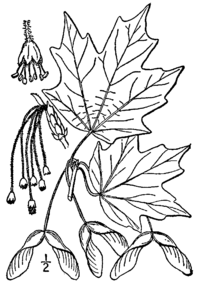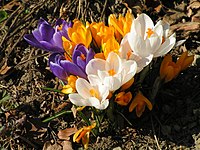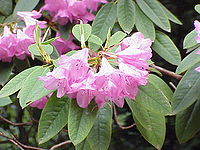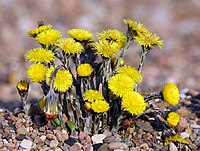Bloom Clock/Keys/New Hampshire/April/All
Bloom Clock Keys for New Hampshire, All flowers in April
Acer rubrum
 Wikipedia • Commons • Wikibooks (horticulture) • Wikibooks (subject) • Wikispecies • Fruit and seed clock |
Profile for Acer rubrum (Red Maple)
Recent Logs[edit | edit source]
| ||||||||||||||||
Global data:
Temperate zone season(s): Early Spring, Mid Spring
Acer saccharinum
 Wikipedia • Commons • Wikibooks (horticulture) • Wikibooks (subject) • Wikispecies • Fruit and seed clock |
Profile for Acer saccharinum (Silver Maple)
Recent Logs[edit | edit source]
| ||||
Global data:
Temperate zone season(s): Early Spring, Mid Spring
Acer saccharum
 Wikipedia • Commons • Wikibooks (horticulture) • Wikibooks (subject) • Wikispecies • Fruit and seed clock |
Profile for Acer saccharum (Sugar Maple)
Recent Logs[edit | edit source]
| ||||
Global data:
Temperate zone season(s): Early Spring, Mid Spring
Betula
 Wikipedia • Commons • Wikibooks (horticulture) • Wikibooks (subject) • Wikispecies • Fruit and seed clock |
Profile for Betula (Birch)
Recent Logs[edit | edit source]
| ||||||||||||||
Global data:
Corylus cornuta
 Wikipedia • Commons • Wikibooks (horticulture) • Wikibooks (subject) • Wikispecies • Fruit and seed clock |
Profile for Corylus cornuta (Beaked hazel)
Recent Logs[edit | edit source]--Jomegat 16:52, 25 March 2010 (UTC) | ||||||||||||||
Global data:
Crocus
 Wikipedia • Commons • Wikibooks (horticulture) • Wikibooks (subject) • Wikispecies • Fruit and seed clock |
Profile for Crocus (Crocus)
Recent Logs[edit | edit source] | ||||
Global data:
Epigaea repens
 Wikipedia • Commons • Wikibooks (horticulture) • Wikibooks (subject) • Wikispecies • Fruit and seed clock |
Profile for Epigaea repens (Trailing Arbutus, Mayflower)
Recent Logs[edit | edit source]
| ||||||||||||||||
Global data:
Forsythia x intermedia
 Wikipedia • Commons • Wikibooks (horticulture) • Wikibooks (subject) • Wikispecies • Fruit and seed clock |
Profile for Forsythia x intermedia (Garden Forsythia)
Recent Logs[edit | edit source] | ||||||||||
Global data:
Temperate zone season(s): Early Winter, Mid Winter, Early Spring, Mid Spring
Narcissus
 Wikipedia • Commons • Wikibooks (horticulture) • Wikibooks (subject) • Wikispecies • Fruit and seed clock |
Profile for Narcissus (Daffodil, Jonquil, Narcissus)
Recent Logs[edit | edit source]
| ||||||||
Global data:
Temperate zone season(s): Early Spring, Mid Spring, Late Spring
Narcissus pseudonarcissus
 Wikipedia • Commons • Wikibooks (horticulture) • Wikibooks (subject) • Wikispecies • Fruit and seed clock |
Profile for Narcissus pseudonarcissus (Daffodil)
Recent Logs[edit | edit source]Archived Logs[edit | edit source]
| ||||
Global data:
Rhododendron
 Wikipedia • Commons • Wikibooks (horticulture) • Wikibooks (subject) • Wikispecies • Fruit and seed clock |
Profile for Rhododendron (Rhododendrons and Azaleas)
Recent Logs[edit | edit source] | ||||
Global data:
Temperate zone season(s): Early Spring, Mid Spring, Late Spring, Early Summer, Mid Summer
Salix
 Wikipedia • Commons • Wikibooks (horticulture) • Wikibooks (subject) • Wikispecies • Fruit and seed clock |
Profile for Salix (Willow, Sallow, Osier)
Recent Logs[edit | edit source] | ||||||||||||
Global data:
Temperate zone season(s): Early Spring, Mid Spring
Taraxacum officinale
 Wikipedia • Commons • Wikibooks (horticulture) • Wikibooks (subject) • Wikispecies • Fruit and seed clock |
Profile for Taraxacum officinale (Common Dandelion)
Recent Logs[edit | edit source]
| ||||||||||||||||||
Global data:
Temperate zone season(s): Mid Winter, Late Winter, Early Spring, Mid Spring, Late Spring, Early Summer, Mid Summer, Late Summer, Early Fall, Mid Fall, Late Fall, Early Winter
Tussilago farfara
 Wikipedia • Commons • Wikibooks (horticulture) • Wikibooks (subject) • Wikispecies • Fruit and seed clock |
Profile for Tussilago farfara (Coltsfoot)
Recent Logs[edit | edit source]
| ||||||||||||||
Global data:
Ulmus americana
 Wikipedia • Commons • Wikibooks (horticulture) • Wikibooks (subject) • Wikispecies • Fruit and seed clock |
Profile for Ulmus americana (American Elm)
Recent Logs[edit | edit source]
| ||||||||||||||
Global data:
Temperate zone season(s): Mid Spring
